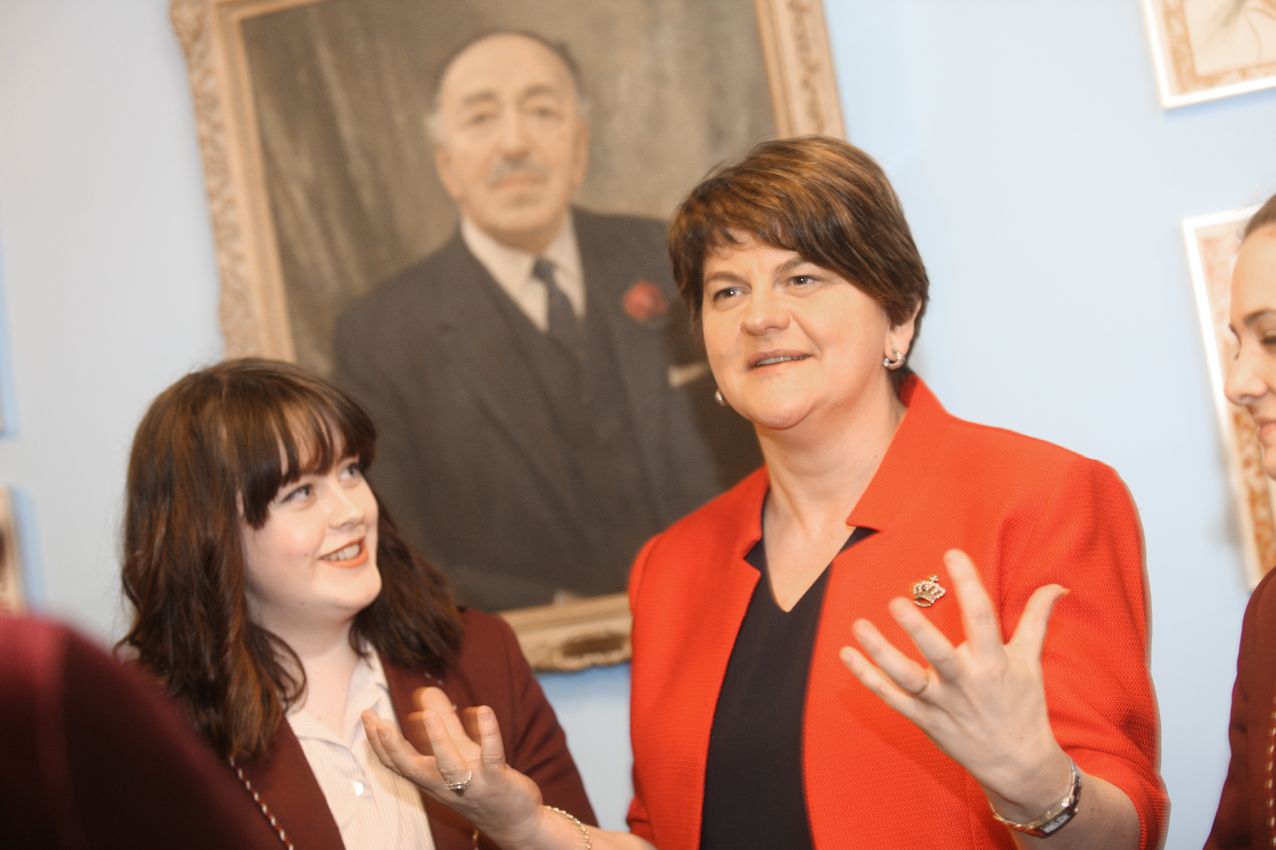THE past and present leaders of the DUP are currently singing off the same hymn sheet when assessing the tensions around the unionist rejection of the Irish Protocol.
Peter Robinson’s assertion in a recent News Letter article that “we are perilously close to a line which, when crossed, will lock us all into a pattern all too familiar to my generation” would rightly be pounced on by political opponents and sections of the media if it were uttered by a Sinn Féin representative. DUP Leader and First Minister Arlene Foster told RTE that it is “dangerous when people think they’re being sidelined and not listened to.”
Peter Robinson says that unionists “are more alienated than I have seen at any time in my 50 years in politics.” He omits the anti-civil rights campaign in the 1960s; pogroms in 1969; the UWC strike in 1974; DUP-led strike in 1977; reaction to Anglo-Irish Agreement 1985; anger at the Downing Street Declaration and rejection of the Good Friday Agreement in 1998. His claim that there is a danger that for some unionists all of this will lead to an “estrangement from the political arrangements” that may then be “vented more robustly”, when taken along with Foster’s warning of danger, must be taken seriously.

.@DUPleader response to the the question of a border poll in Northern Ireland and would she stay if there was a United Ireland. Watch the full interview on #rtetwip tonight at 23:15 on @rteone. #rtepolitics #NIpolitics #borderpoll pic.twitter.com/6lnXv3506i
— The Week in Politics (@rtetwip) March 28, 2021
The rest of us are very mindful of the symbiotic relationship between political unionism, its use of language and the role of paramilitary groups like the UVF, UDA and Ulster Resistance in the conflict.
Words matter. Leaders who allow a vacuum to develop cannot be suprised if others fill it. Those who deliberately create such vacuums for their own narrow party political ends are playing with fire The late David Ervine was clear in his denounciation of the DUP’s role in exploiting loyalist anxieties. His successors would do well to read his words.
Arlene Foster talks of leaving the North in the event of a Yes referendum vote for a United Ireland.She talks about being comfortable now living in Fermanagh “even though nationalists are the majority” there. But she goes on to say: “I cannot see how I could be British in Fermanagh, in a United Ireland, because by the very definition you are no longer British because you are living in an all-Ireland state.”
I see no reason for Arlene to leave Fermanagh. That will be her decision, of course, not mine. But Fermanagh is her home place regardless of its future constitutional status. Why anyone who suffered during the conflict and survived as she has would voluntarily leave such a beautiful peaceful place simply because it would be part of a United Ireland is worthy of deeper analysis. Maybe Arlene should eloborate.
I have lived all my life under British rule, including decades of British military occupation. I have been denied my civil rights, including up to this day my Irish language rights. I have been imprisoned for years without charge or trial, censored, assaulted in custody and on the streets. I have been shot. I live to this day under death threats. My home has been bombed. I never ever thought of leaving. This is my home place also.
It is also the home place of the handfuls of young people, some of them children, who are attacking the PSNI. They will have little option but to stay. What future will they have? Why are they attacking the police? Unionist leaders say it is because of Bobby Storey’s funeral. Nonsense.
In his News Letter article Peter Robinson spoke of the “odour of betrayal in the air.” That odour comes from an English government that imposed Brexit against the democratic wishes of the majority of people in the North. It comes from the DUP’s rejection of the democratic vote of the people of the North to stay in the EU. It also comes from a DUP stance that made a mess of every subsequent Brexit negotiation before being abandoned by the Tories when they signed up to the Irish Protocol. And yet Boris Johnson, the great betrayer, is embraced by the DUP leader when he comes to the North.
Does Boris Johnson care about young loyalists? Of course not. Do the unionist parties?
Do we?
The Second Battle of Moore Street is being fought out
DEFENDING HERITAGE: James Connolly Heron, great-grandson of James Connolly, addresses a Save Moore Street rally in the famous thoroughfare. 
AS you read this week’s column cast your mind back to Dublin 105 years ago. Pádraig Pearse and James Connolly had stood at the entrance of the GPO on Monday and issued the Proclamation of The Republic to the Irish People. Hundreds of men and women had then moved to occupy strategic buildings and locations across the city. For several days they had been involved in a deadly battle with overwhelming numbers of British soldiers using heavy machine guns, artillery pieces and the guns of British naval ships in Dublin Bay. British Army barricades were across many city centre streets. Much of Dublin’s city centre lay in ruins.
After five days of fierce fighting and with the GPO in Sackville Street (now O’Connell Street) in flames the Volunteers were forced on the Friday evening to evacuate that position. There was a British Army barricade at the top of the street where it joined with Parnell Street. The O’ Rahilly led a failed charge to break through into Parnell Street. Wounded, he was to die against the side wall of 25 Moore Street after writing a last poignant letter to his wife. Carrying a wounded James Connolly, and under constant machine gun and sniper fire, the GPO Garrison made their way across Henry Street to Number 10 Moore Street. They broke through the outside wall of Number 10 and began tunnelling their way up through the terrace of houses.
The next morning – Saturday – five of the signatories to the Proclamation, Pádraig Pearse, Seán Mac Diarmada, Tom Clarke, James Connolly and Joseph Plunkett, met in Number 16. There they discussed their next steps. Surrounded on all sides by British forces, with no prospect of success and concerned about the ongoing risk to civilians, the leaders reluctantly decided to surrender. They knew they were likely to be executed. According to Joseph Sweeney, who was there, Seán Mac Diarmada later told a meeting of the Moore Street Volunteers that “this was only the beginning of the fight and that all the leaders would be executed.” He added: ‘But it is up to you men (and women) to carry it on.” He was right.
Decades later Moore Street and the lanes surrounding it – The Battlefield Site – stand alongside national monuments in other states around the world where the right to independence and freedom was fought for. It is, as the National Museum of Ireland has described: “The most important site in modern Irish history.”
Regrettably, successive Dublin governments have taken a different view, preferring to back private developers whose plans would see the destruction of much of this iconic area.
Currently a second battle of Moore Street is taking place. A company called Hammerson is about to lodge a planning application for a development that would ruin the Battlefield Site if it is given the go-ahead.
Relatives of the Signatories of the Proclamation have come together as the Moore Street Preservation Trust and have begun releasing details of their vision for a 1916 Historic Cultural Quarter. Their proposal, which is expected to be formally launched in the next month, will reflect the aims and ideals of the men and women of 1916 while supportive of the trading tradition of the area. In recent weeks they have published architectural and conceptual images of what the Moore Street Battlefield Area could look like.
Their plan envisages the restoration of the Moore Street Terrace and the adjacent lanes to make it a place of culture, respecting the history of the area, ensuring that visitors and local people enjoy the area and at its heart create a ‘Living Museum’ which will educate and encourage research into that important period of our history.
Sinn Féin too has been arguing for the area to be protected. Two weeks ago Sinn Féin TD Aengus Ó Snodaigh published a Bill in the Oireachtas to give legal recognition to An Cheathrú Chultúir 1916 (the Moore Street Cultural Quarter). His proposal calls for the creation of a management and oversight company for the Quarter and to establish a permanent outdoor Market within Moore St – which is Dublin’s oldest food market.
Speaking in the Dáil where the Bill passed second stage unopposed and now goes into Committee stage Teachta Ó Snodaigh said: “This Bill when enacted would demonstrate that we in fact value Irish history, culture and the memory of those who died for Irish freedom... An Cheathrú will be tasked with the preservation, restoration and management of the Cultural Historical Quarter”.
In the next few weeks a Ministerial Advisory Group is to make a report to Fianna Fáil Minister Darragh O’Brien on the future of Moore Street. While he was in opposition in 2015 O’Brien published a Bill which had the aim of preserving the Moore Street site and called for it to be designated as “a historical quarter.” However, his reluctance to engage with the relatives on this issue has raised serious concern that a developer’s plan will be given priority over the needs of the local community and the future of this iconic historical area.







